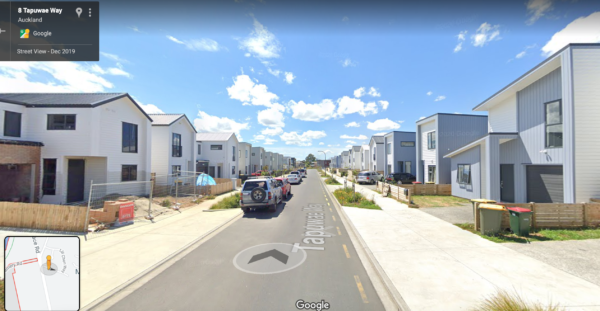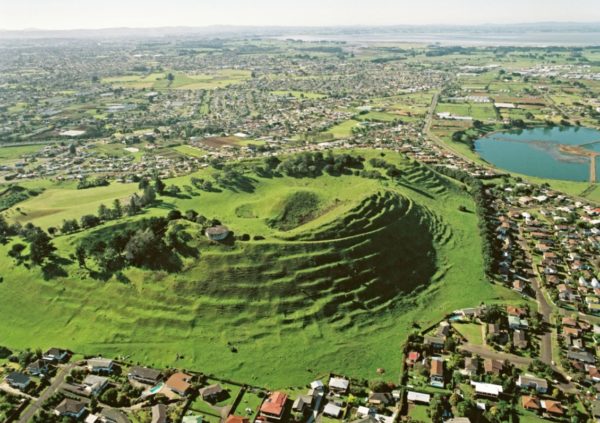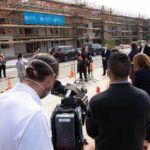This is a guest post by Konrad Kurta. This was originally published by Konrad on the Mangere Bridge community facebook page, when he and his family were preparing to move into their new home, in a development of new townhouses on Taylor Road. Konrad is a regular commenter on Greater Auckland, and has contributed guest posts in the past.
WARNING: this is a long post about housing on Taylor Road and the community in general. If you want updates on which helicopter is chasing which unregistered dirt bike, I’d strongly recommend you skip this post! Anyway…
I’m sure you’ve read a lot recently about housing developments in the area. And I’m sure you’ve read a lot from concerned residents worried about the impact it’s going to have.
I thought it was only fair you heard from someone who plans to live in one of those houses…
My wife, my little boy, and me, to be exact. That’s us in the picture.

We’re moving in because we love the neighbourhood – we rent here already. Most of our extended family lives here, too. A two bedroom townhouse is what we can afford after 15 years of saving.
If you’re worried about the impact it will have on the street and the neighbourhood, I understand. Auckland hasn’t built enough houses for decades, and we need to build literally tens of thousands now to make up for it.
That means change for neighbourhoods like ours. And I think we all agree that change brings uncertainty.
But I don’t think those changes are as drastic as some people are making out. I know medium density buildings look different to what’s here now, but the impacts won’t be huge.
All the developments will pay to have their rubbish removed onsite. There will actually be fewer bins on the road than there are now.
The ‘lots more traffic’ idea also doesn’t quite stack up, either. Taylor Road is mostly deserted even during peak times. A few dozen vehicles leaving for work between 8 and 9am won’t change that.

And there’s more to it than that.
More houses means more kids to join the soccer and tennis clubs. More parents like me to be coaches. More families like us to look after your kids, to share a BBQ with, or to force our kids to mow your lawns for pocket money.
And I’m sure you know what the local businesses would say if you told them they’d get more customers…
I’ll admit I find the tone of the conversation a bit frustrating…almost every complaint comes from people who bought a large house before prices skyrocketed.
For families like us, medium-density housing is all we can afford. It means we can live less than an hour’s drive from work and still have a little bit of time to spend with our kids.
When you’re worried about new houses, I’d like for you to ask yourself…what’s the worst that could happen?
In developments all over Auckland, people don’t notice much change once the houses are built and people live there. Rimu Rd is a classic case in point. When building is finished, there’ll be a few more cars, a few more friendly faces, and a few more junior members at the local sports clubs.
These aren’t empty houses maliciously trying to block your 8pm sunshine. They’re homes for people like you.
People like us.
Images in slideshow sourced from the Kainga Ora website.
We just want somewhere where we can live with security, get to work in less than an hour, and raise our kids.
My little boy in the picture? I hope he’ll get to spend his childhood in the Bridge. The people are great, the area is lovely, and it’s not too far from most things.
Sensible medium density buildings work all over the world, including Auckland. It encourages people who want to make a life here, and breathes new life into the community.
In that case, you might find some townhouses change our neighbourhood for the better. So grease up your lawnmower. I’ve got a kid who’ll need some pocket money.
Cheers,
Konrad





 Processing...
Processing...
Good to read this personal story. Thanks for sharing.
Please give an actual opinion.
Nice place Mangere Bridge. Walk or cycle to Onehunga good bus routes to Mangere Papatoetoe and Manuka. Walk up the mountain for some exercise.
We looked at Mangere Bridge when we were thinking of buying, great spot..just would have meant long PT commute or driving as the connection PT wise is useless. If LR goes in it will get even better!
There are many old, cold, run down, sunless, viewless homes in Auckland. I bike around these areas quite often and see some well cared for homes and a nice garden but many are not. The run down homes are being demolished to make way for better quality and more variety. I’m sure a move to a new develpment and a modern design would be appreciated by most people.
Some new suburbs where they have only increased intensity in a small amount will continue to have transport, parking and congestion issues.
For our public transport system to give most benefit we need more people living close to bus or train stops.
Another positive aspect of the new developments will also be in air quality. I assume most will be going down the heat pump or even passive heating route. My partner cannot go out of the house some days when locals are burning all kinds of dubious materials in their fires.
These housing improvements are transformational for any urban area, replacing old,cold houses on large sections with warm dry compact modern places to live. What is “lost” is the large back yard,and parking space.
It is therefore incumbent on the powers that be, to ensure that public spaces ,parks are retained,enhanced for recreational purposes. The access to these public spaces should be easily accessible by families,on foot or two wheels, without being confronted by excessive traffic.The other fly in the ointment is car parking, normal human behavior will prevail,with every available space, legal or not, will get a car parked on it. I would hope there is some oversight on this to prevent it from happening. The other normal behavior ,sadly,is that vehicles parked on the road,present an opportunity for theft , reasonably prevalent in our central Auckland suburb. This requires a change in thinking on excessive car ownership.
Some bike priorities are proposed for Mangere Bridge,but it has very poor connection to train at Onehunga,$39 million spent on the pedestrian/cycle bridge,then just spat out onto the road.
I ran a campaign on the transport blog for a station at Onehunga port when the Onehunga line was reopened in 2011. Absolutely no support
From all the wise commentators. Some still post on this site.
The railway reservation that is still there would make a great cycleway connection to Onehunga station. Shouldn’t be that expensive, presumably some government agency owns the land.
Thank you for the post Konrad!
nimbys paint their actions as them being the little guy going up against the big bad high profit developer, who’s cramming people in.
When in reality its people they’re actively denying housing with their lobbying.
The other thing you never hear nimbys complaining about is when they go to sell thier house that once upon a time was zoned as single dwelling but has now changed to THAB and is now worth nearly double the price which was already exhorbitantly high to begin with.
Great post, thanks for sharing Konrad. I’m an apartment dweller myself, so I’ve not lived in a townhouse, but I’d like to gauge your opinion on how well it works for you. Couple of questions – do you have a shared wall with your neighbour? One side or both sides? How is the noise level that comes through the wall – is there any? Nothing? A lot? Do you have a back yard, or side yard at all? Do you have anyone else living above you, or below you? Lastly – is it warmer, drier, quieter than where you lived before? I hope you don’t mind the personal questions.
I have never lived in a town house in NZ, so it will be interesting to hear a NZ reply to this question, but having lived in townhouses in the UK I never heard anything from my neighbors ever – so not a problem in my experience.
Adam – you probably had a brick wall between you and your neighbours over in the UK. For various seismic reasons, we tend not to build brick walls any more – but timber-framed walls are a poor substitute.
It still not your average indoor wall though. I assume there has to be fireproofing between units. It is also possible, and as far as I know not overly expensive, to soundproof these walls.
My experience in a townhouse is similar, I don’t hear my neighbours through the common wall.
I lived in a townhouse with a shared wall for a while. Built in the early 2000s.
Lived there for about 2 years, never heard a peep from my direct neighbours. I’m unsure if thats because the 3 different groups that lived there were extremely quiet, very unlikely though. Despite the shoddy building, monolithic cladding, flat roof forming the balcony over part of the house, slight leaking issues, standard for early 2000s, it was by far warmer and less damp than the standalone house I live in now.
It was overall an example of what not to do, but it was fine. Every piece of ground not a house was covered with concrete parking, almost no garden / green, awful architecture, cheap buildings, 3 car parks per flat (we didn’t own a single car).
Despite all that it was relatively warm and not mouldy, had fast internet, and was close to a good bus route. Students dream, particularly because it was relatively affordable for us.
More modern versions of these developments seem to be much more reasonable in those negative points from what I can tell.
I have lived in a small apartment block before and they are incredibly noise proof – much more so than standalone home. The concrete walls between units really keeps everything warm and quiet.
Haven’t moved in yet – NIMBY’s kicked up a stink to the point it gummed up the consenting process and has pushed the development back a few months. Completion was theoretically Feb next year, though I’d imagine it’s more like April now. Have talked to a few people who live in near-identical developments by the same company and the feedback is the same – quiet, can’t hear neighbours, warm, dry. One car park each per dwelling, and a little landscaped yard for all townhouses (with proper yards and grassed area for some dwellings in order to meet planning regs for ground permeability). Our current house is 2 bedroom standalone – nice enough, though cheaply built and doesn’t retain heat very well. Have lived in a 3-level brick apartment block in inner Melbourne previously. LIfestyle is great, as long as you can trade off the ‘back yard’ things for parks and recreation areas close by…especially if you have kids. That’s definitely one thing Auckland needs to focus on (better use of recreation spaces/planning for density), plus a step change in public transport and active mode planning.
Thanks heaps Konrad, excellent feedback. Good to hear.
I am not Konrad, but we bought a terrace house last year.
No internal noise at all from neighbours, although I understand our place was built a bit above code.
Beautifully dry and warm in winter. We have only had the heat pump on about 7 days this winter, and no need for heaters.
To be honest the bigger issue is the home often gets too hot in summer.
The neighbours sometimes have social functions of 15-20 people, even then hardly hear a peep.
Thanks Zen – do you happen to know what your boundary wall is made of? Timber frame do you think? or is it possibly a concrete precast panel wall?
Your note that it gets too hot in summer is interesting – is there any built-in ventilation / extraction / apart from opening a window?
My 2 cents is:
If my house was well insulated then I’d try set up some sort of window covering / shading and get the heat pump going as an air conditioner. Just lightly, drops the humidity out of the air which is almost the bigger issue with feeling too hot and sticky.
Yep get a heat pump (we ended up getting a ducted which you would never regret) and turn it to the temp you want 24×7 summer and winter. If it’s insulated it is pretty cheap and very nice.
It’s got a ground floor heat pump which can keep downstairs cool but it doesn’t help much for upstairs.
I will probably invest in one of those portable aircon units this summer.
Average human, this is the description in the specs:
‘All intertenancy walls between homes are double stud wall construction including 25mm thick Gib Barrierline, with an overall wall thickness of 300mm.
The double stud wall has a design STC of 61 (code requires just 55) and is fire rated as required by the New Zealand Building Code’
Good post. I get the feeling that lots of people used to be nimbies but it’s dying out now. So many chances to wake up. It’s just not very cool to be anti-green, anti-wellbeing, anti-climate action.
Nah, I hear it all the time (“horrible shoeboxes”, “no parking”, etc). We might be getting units next door to us and I would prefer not as it will massively overlook our back yard; but at the end of the day I don’t own that land and we live in a capitalist country so I think they should be able to build what they want within reason.
They should be allowed to build up to the property line, that makes it more likely that whatever townhouses or apartments will overlook their own yard and the street instead of the neighbours.
Hi Konrad, great post, thanks. My wife & I moved to Mangere Bridge 40years ago for three reasons. Firstly, it’s a clearly defined suburb with the motorway on it’s eastern boundary and the harbour north & west. Secondly, it had a good diversity in housing types and ages (back then). Thirdly it has good access to South Auckland and the airport for work. Those factors all still apply and I’m not surprised that the community response to change is strongly conservative as I think the distinct spatial definition makes it an easy place to clearly identify with. Unlike say, Glendowie – where does that start and end?
So I’m pleased to hear that a place we loved living in for ten years is still attracting new residents passionate to be there. Obscure fact: ex PM David Lange lived in Mangere Bridge for some time, maybe up until his death.
Glendowie – where does that start and end?
Maskill St and Crossfield Road, West Tamaki and to the water on the other side? Maybe Mas It’s pretty much the same as how you describe Mangere, with the West Tamaki ridgeline serving the same purpose as the motorway.
Do you have enough sunshine and privacy when property are so close to each other?
Also do you feel your kids has enough space to run around and kick the ball?
If you have unlimited money, do you think living in standalone house provides better lifestyle and livability?
Check out some of those tightly packed 2 storey houses in Flat Bush.
No views on 3 sides. A street view from the upstairs bedroom.
The double garage for accommodation.
2 plus cars parked on large concrete yard.
Small or non existant garden
1. Sunshine yes, privacy yes, bedroom windows don’t directly face other bedroom windows, can have blinds etc if you’re really worried.
2. Yes, there’s a few parks within 2 minutes walk. As mentioned in the post a stronger emphasis by Council does need to ensure open space is provided for in developments.
3. Unlimited money, wow great question. Better lifestyle and livability is a personal opinion right? One persons view will likely differ to others.
Good to see the communal car park at the Kainga-Ora apartments.
So many townhouses have been built with pointless garages too small to fit the vehicles people own, let alone allow a door to be opened once inside (Waimahia Inlet, for example).
A well laid out car park overlooked by the properties it serves prevents pave-parking, saves built footprint for living space and helps reduce the dominance of vehicles in the street.
The Greensborough area (the Knighton Road, Cameron Road, Old Farm Road triangle) near Waikato university has nearly doubled in population and density in the last 20 years. This was never a very high income area, and most of the owner occupiers seem to have been happy to sell up. The new housing is 2 and 3 storey apartment blocks, which students seem happy with. Admittedly the new and expensive housing along nearby Nottingham Drive is low density. I’ve sometimes thought this rapid change would make a good research project, but no longer live in Hamilton.
That first image of a street in MB looks good. And looks like some trees have been planted, so that will look great eventually.
I particularly like the road layout. Outside of the parking bays, its too narrow for people to park on the street, though i guess many will straddle the footpath outside their garage. Sigh.
Thanks for that, Konrad.
But my lawnmower’s electric.
The ironic thing is that you have to go as far as Mangere bridge to buy a townhouse “close to the city” because so much of the land that is actually close to the city is zoned single house and similar.
Yeah.
Although even if much more of the isthmus was zoned for higher densities, it might enable more townhouse options but it will also be pricier.
Although of course *some* of the extra cost might potentially be cancelled out by lower transport costs.
Upzoning everywhere (and removing the regulations that prevent a site-by-site intensification process) would reduce the prices, too, by removing the scarcity value of developable land. The current pattern of drip feeding a supply of land for upzoning serves to prevent a reduction in house prices and does nothing to ensure a ‘constant supply of land’.
It’s nice in theory Heidi, it’s what I used to think.
But that’s not borne out by the AUP experience – lots of new density was enabled across widespread areas, prices soared rather than levelling out or flattening.
I think the reason for that is despite widespread upzoning, there’s only a subset of sites that are good for redevelopment in terms of slope, dimensions, services etc.
Sure if you double the number of sites zoned for density then you might double that subset…
But I’m still not that convinced by the theory.
I notice in the picture of Taylor Road the cars parking on the road (reducing it to one lane), no off-street parking bays, and plenty of grass berms. I live in one of the new subdivisions (Huapai Triangle) where we have some off street parking bays, but could do with some more. The problem with grass berms is that they are not maintained simply because that little strip of grass is the only piece of grass associated with that house, and the owners are certainly not going to shell out close to $500 for a mower to maintain it, and the council doesn’t maintain grass berms these days making the whole area look untidy. My suggestion is to replace the grass berms with off-road parking bays (keeping the trees), and getting the parked cars off the road.
Does every house on your sub division not have at least a single garage and driveway? What are the parking bays for
I agree about the inefficiency of requiring each resident to own a lawnmower – or to pay someone to come and mow in an inefficient pattern.
Far more efficient for Council to do them all, one after another.
However, the grass berms are important for reducing the urban heat effect.
Despite this, most new housing in Auckland is in the form of apartments, due to the council’s prejudice against single-family houses like these.
These aren’t single family houses.
Its terrace housing.